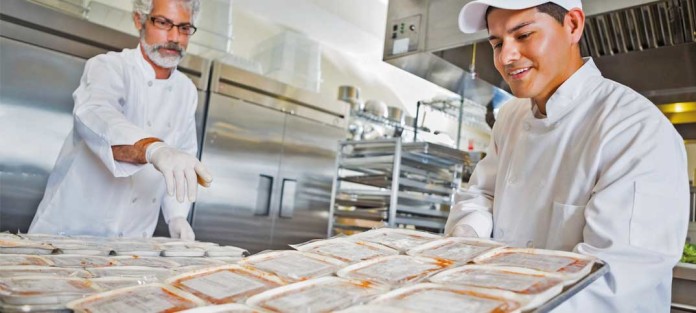The head of Landmark Wholesale’s new Caterer Connections programme, Chris Doyle, tells Tan Parsons how it will help those wholesalers who join it to get the most from the foodservice market.

BW: Why has Landmark launched Caterer Connections?
CD: We recognise the complex challenges and demands faced by those in the delivered foodservice and cash & carry catering trades, and we’re confident that Caterer Connections will step-change businesses.
What reaction have you had from your members to its launch?
Our mission was to sign up all our out-of-home members and 30 key out-of-home suppliers to the new
Caterer Connections Club, and I’m delighted to say that we have achieved this. We’re confident that this will attract new foodservice members, as recent additions to the Landmark Group, such as RD Johns and Turners Fine Foods, have been really impressed by it.
Landmark has never before had a joined-up model like this. It’s a new business development package for members and suppliers to the out-of-home market. We’ve got new people on board with catering and on-trade experience, who have helped pull it all together. It’s a huge body of work.
Who is in the team?

We have combined our trading and business development expertise to create a dedicated Caterer Connections team. This comprises foodservice controller Les Mohammed and on-trade controller Martin Spivey, who have a combined 40 years’ in the foodservice industry, as well as marketing controller Philip Marx and our publishing agency Summersault.
How is the foodservice market different to retail?
Historically, the challenge for all wholesalers in foodservice is that there is no single market or type of customer: what a pub wants is completely different to what a school, care home or fish and chip shop wants. So that’s where wholesalers struggle to get to grips with the market.
By comparison, retail is pretty straightforward – the formula is pretty much the same, no matter who the customer is. That’s why a lot of traditional cash & carry wholesalers find it a challenge to service foodservice.
How does Caterer Connections help?
What we’ve said is that if you can’t have a symbol group model that works, such as Lifestyle Express or Premier, then let’s have a single process that fits all foodservice operators, members and suppliers. The reason the Caterer Connections model works is that it provides the three crucial connections needed to deliver growth in foodservice: supplier to depot, depot to caterer and supplier to caterer. We’ve created a simple process that does all three things.
What does it involve?
We have one-to-one events across the year where suppliers can work with members on developing existing and new caterer channels and products.
Second, there’s a new Caterer Connections magazine for all our out-of-home customers. Let’s say we have a feature for pubs on traditional dinners, for example – we then invite the supplier to contribute and give the relevant facts about its products.
We also have three brand new essential product catalogues – one for on-trade, one for quick service (take-aways and coffee shops) and one for the cost sector (schools and care homes). These contain participating suppliers’ key products. Caterers can read the catalogues and plan how and when they should be using the listed essential products. These really are a one-stop shop for those working in foodservice.
Finally, we have a revamped promotions leaflet. If it’s Unilever’s bouillon, for example, we might include it in a recipe idea for a traditional dinner, so it’s more than just a list of deals. It’s caterer inspiration. It also works out profits for the caterer and the supplier can get its products in front of the caterer.
What do the one-to-one Caterer Connections Club events involve?
At our last event, we had 20 members representing about 50 depots and 30 suppliers. The Landmark board agreed with me that this would be 100% focused on out-of-home business development. I didn’t want suppliers or members to talk about retail. We already have a very well established set of business development vehicles dedicated to retail.
Which suppliers are involved?
CD: We went out and cherry-picked 30 suppliers across chilled, ambient, on-trade and non-food that are really important to foodservice. We think this is sufficient to cover the essential products every caterer should be considering in his or her business.
So is this aimed mainly at Landmark members who just do foodservice?
No. It’s aimed at traditional cash & carry wholesalers supplying caterers as well. Parfetts, for example, is very well known for its successful retail business but it also has ambitions out of home – Caterer Connections provides a useful platform it didn’t have in the past and it is using it as a springboard for business development.
Equally, delivered-only members that have recently joined Landmark, such as Brook Street Foodservice and Turners Fine Foods, have fed back that Caterer Connections adds a lot of value to their membership of Landmark.
We believe it is a really significant reason for wholesalers to join Landmark, whether they are delivered foodservice-focused or a traditional cash & carry member. Overall, Caterer Connections is a genuine and rare opportunity to step-change, for both suppliers and members, and we are challenging them to grab it with both hands.











